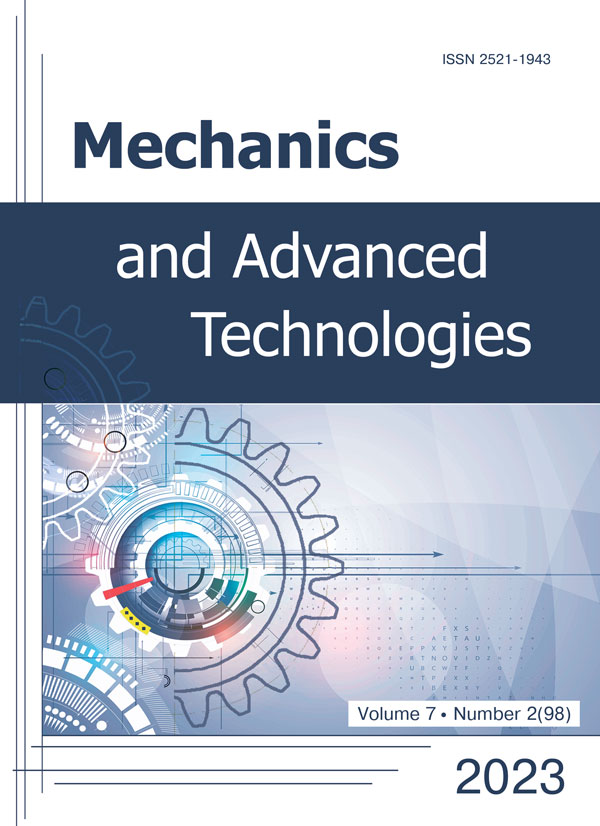Determination of the KIC Fracture Toughness of the X210Cr12 High-Strength Material
DOI:
https://doi.org/10.20535/2521-1943.2023.7.2.282705Keywords:
fracture mechanics, fracture toughness, crack opening displacement, high strength steels, X210Cr12Abstract
Purpose: It is an important problem that the machines become unusable due to the deformation of the machine elements produced before the planned time. In this study, it was aimed to determine the KIC value of X210Cr12, which is a high strength material. In this way, more accurate load values can be used in the design.
Methods: In the experimental study to determine the KIC value, the sample geometry, the crack depth, the load-dependent parameters and calculations and some conformity checks were carried out. Experimental system; KIC consists of 3-point flexure specimens, a press, an electronic circuit capable of detecting the change in load crack opening, and a logger.
Findings: In the study, the loads were determined from experimental graphs. Subsequently, load-crack opening values were determined. With these data, the KIC values were calculated as 719,7 and 839,7 MPa.mm1/2 as the minumum and maximum values, respectively.
Conclusion: The experimental graphs are in the form of curves that break abruptly with unstable crack propagation without showing plastic deformation. There is no study in the literature on the KIC value of X210Cr12 and it has been determined that it has a low KIC value compared to the high-strength steels studied. It is valuable to determine the KIC value, as fracture problems may occur in designs prepared with the material. The results of the study are data at room temperature.
References
- T. Aikawa and T. Kawabata, “Consideration on the toughness difference depending on the direction of brittle crack propagation in very thick steel”, Procedia Structural Integrity, vol. 21, pp. 173–184, 2019. DOI: https://doi.org/10.1016/j.prostr.2019.12.099.
- ASTM-E399-12:2013. Standard Test Methods for Plane-Strain Fracture Toughness of Metallic Materials. American Standard Institution.
- E. Ateş, "Analysis of 3 Different Materials with Fracture Toughness Measurement Methods", master thesis. Uludag University, Graduate School of Natural and Applied Science. Bursa, Turkey, 1987.
- BS 5762:1979. Methods for Crack Opening Displacement (COD) Testing. British Standards Institution.
- C. Fan, Z. Xu, Y. Han, Y. Liu and F. Huang, “Loading rate effect and failure mechanisms of ultra-high-strength steel under mode II fracture”, International Journal of Impact Engineering, vol. 171, p. 104374, 2023. DOI: https://doi.org/10.1016/j.ijimpeng.2022.104374.
- H. Gao, W. Wang, Y. Wang, B. Zhang and C.-Q. Li, “A modified normalization method for determining fracture toughness of steel”, Fatigue & Fracture of Engineering Materials & Structures, vol. 44, no. 2, pp. 568–583, 2021. DOI: https://doi.org/10.1111/ffe.13380.
- J. F. Kalthoff and A. Bürgel, "Influence of loading rate on shear fracture toughness for failure mode transition", International Journal of Impact Engineering, vol. 30, no. 8-9, pp. 957-971, 2004. DOI: https://doi.org/10.1016/j.ijimpeng.2004.05.004.
- P. Koester, C. Benz and M. Sander, “Investigation of mixed mode fatigue crack propagation in SEN-specimen under in-phase and out-of-phase conditions due to tension-compression and torsional loading”, in MATEC Web of Conferences, vol. 300, p. 11006, 2019. DOI: https://doi.org/10.1051/matecconf/201930011006.
- D. M. Kulkarni, R. Prakash and A. N. Kumar, “Experimental and finite element analysis of fracture criterion in general yielding fracture mechanics”, Sadhana, vol. 27, no. 6, pp. 631–642, Dec. 2002. DOI: https://doi.org/10.1007/BF02703355.
- W. Ma and Z. Duan, “Investigation of mode II crack growth following a very high speed ımpact”, Journal of Mechanics of Materials and Structures, vol. 3, no. 2, pp. 271–290, Feb. 2008. DOI: https://doi.org/10.2140/jomms.2008.3.271.
- A. Neimitz and J. Galkiewicz, “The experimental-numerical analyses of the failure mechanisms of S355JR steel”, Theoretical and Applied Fracture Mechanics, vol. 108, p. 102666, 2020. DOI: https://doi.org/10.1016/j.tafmec.2020.102666.
- E. Orowan, “Fracture and strength of solids”, Report on Progress in Physics, vol. 12, no. 1, pp. 185–232, 1949. DOI: https://doi.org/10.1088/0034-4885/12/1/309.
- G.C. Sih, Handbook of stress-intensity factors: stress-intensity factor solutions and formulas for reference. Bethlehem, PA: Institute of fracture and solid mechanics, Lehigh University, 1976.
- A. Shukla, Practical Fracture Mechanics in Design, 2nd Edition. Boca Raton: CRC Press, 2004, 522 p. DOI: https://doi.org/10.1201/9780849338939.
- V. T. Troshchenko and V. V. Pokrovskii, “Fatigue Fracture Toughness of Metals and Alloys. Part 1. Experimental Procedures and Materials and General Principles”, Strength of Materials, vol. 35, no. 1, pp. 1–13, 2003. DOI: https://doi.org/10.1023/A:1022909018616.
- A. A. Wells, The condition of fast fracture in aluminium alloys with particular reference to comet failures. British Welding Research Association, 1955, 20 p.
- C. Yan and Y.-W. Mai, “Effect of crack depth and specimen width on fracture toughness of a carbon steel in the ductile-brittle transition region”, International Journal of Pressure Vessels and Piping, vol. 77, no. 6, pp. 313–319, 2000. DOI: https://doi.org/10.1016/S0308-0161(00)00017-X.
- A. Zeinedini, “A novel fixture for mixed mode I/II/III fracture testing of brittle materials”, Fatigue & Fracture of Engineering Materials & Structures, vol. 42, no. 4, pp. 838–853, 2019. DOI: https://doi.org/10.1111/ffe.12955.
Downloads
Published
How to Cite
Issue
Section
License
Copyright (c) 2023 Ерган Атес

This work is licensed under a Creative Commons Attribution 4.0 International License.
Authors who publish with this journal agree to the following terms:
- Authors retain copyright and grant the journal right of first publication with the work simultaneously licensed under CC BY 4.0 that allows others to share the work with an acknowledgement of the work's authorship and initial publication in this journal.
- Authors are able to enter into separate, additional contractual arrangements for the non-exclusive distribution of the journal's published version of the work (e.g., post it to an institutional repository or publish it in a book), with an acknowledgement of its initial publication in this journal.
- Authors are permitted and encouraged to post their work online (e.g., in institutional repositories or on their website) prior to and during the submission process, as it can lead to productive exchanges, as well as earlier and greater citation of published work











